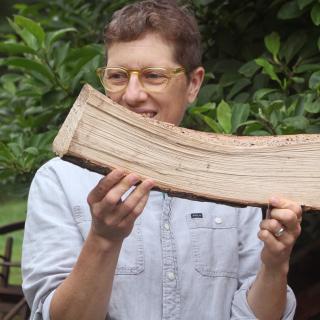Art & the History of Art "Living Material": Talk by Artist Gina Siepel
Skip to Main ContentLiving Material features works emerging from Gina Siepel’s ongoing investigation of the complex relationship between humans and trees. The videos, objects and drawings in this exhibition reflect the artist’s engagement with place, history, materiality, queer experience and ecology.
Siepel is an interdisciplinary artist whose work connects material practice and object making to questions of forest ecology, climate crisis and more-than-human relationships. She focuses on wood as a natural and a cultural material and writes, “My desire is to connect to and critically engage the intimate relationship between histories of colonialism, deforestation and furniture making through my research.” In Living Material, rustic wooden furniture sits atop repurposed Styrofoam packing material, and digital video shares the gallery with seedlings and raw wood shavings. These material juxtapositions highlight the paradoxical aspects of contemporary human-nature relationships that Siepel explores in her work.
Siepel has spent the past three years as an artist-in-residence at the Smith College MacLeish Field Station, observing a selected red oak tree and its immediate forest surroundings. In this project, To Understand a Tree, she is collaborating with naturalist Kate Wellspring and working to deepen her understanding and knowledge of the forest ecosystem, the tree and its interactions with other organisms. Concurrently with work at the forest site, the artist has learned the traditional art of greenwood chair construction. Alternating between contemplating the tree in the forest and splitting, hewing and shaving fallen red oak logs into chair parts, Siepel works closely with wood as both a structural material and embodied evidence of a tree’s life.
To Understand a Tree has been a contemplative and philosophical project, exploring concepts of kinship, recognizing the autonomy and dignity of plant life alongside its “otherness,” and asking ethical questions concerning the harvest of plants for human use. The writings of Robin Wall Kimmerer, along with the work of other Indigenous thinkers and practitioners, have influenced the artist. Siepel writes, “I link this learning to my actions ... cultivating a queer, ecofeminist, and disability-justice-informed ethic of care related to woodworking.”
Gina Siepel earned a B.F.A. in painting and drawing from the School of Art + Design at SUNY Purchase, studied global ecology in the International Honors Program/Bard College, and completed an M.F.A. in interdisciplinary studio art at the Maine College of Art. Her works have been shown in museums and galleries nationally, including the Decordova Museum, Vox Populi Gallery, the Center for Maine Contemporary Art, the Center for Art in Wood and the Colby Museum, among others. Gina has been a fellow/artist-in-residence at the Skowhegan School of Painting and Sculpture, Mildred’s Lane, The Winterthur Museum, Sculpture Space, Hewnoaks and the Center for Furniture Craftsmanship. She has received funding from the Massachusetts Cultural Council, the Berkshire Taconic Foundation, the Puffin Foundation and the Northampton Arts Council. Gina designed and built theater sets and props professionally in New York City and Boston for two decades, and taught "Studio Foundations" at Mount Holyoke College from 2015 to 2022. Gina is currently an artist-in-residence at the MacLeish Field Station at Smith College, and lives in Greenfield, Mass. (Nipmuc, Pocumtuck and Abenaki land).
A reception will immediately follow the talk.
Additional Info
Contact Info
 @amherst.edu
@amherst.edu
